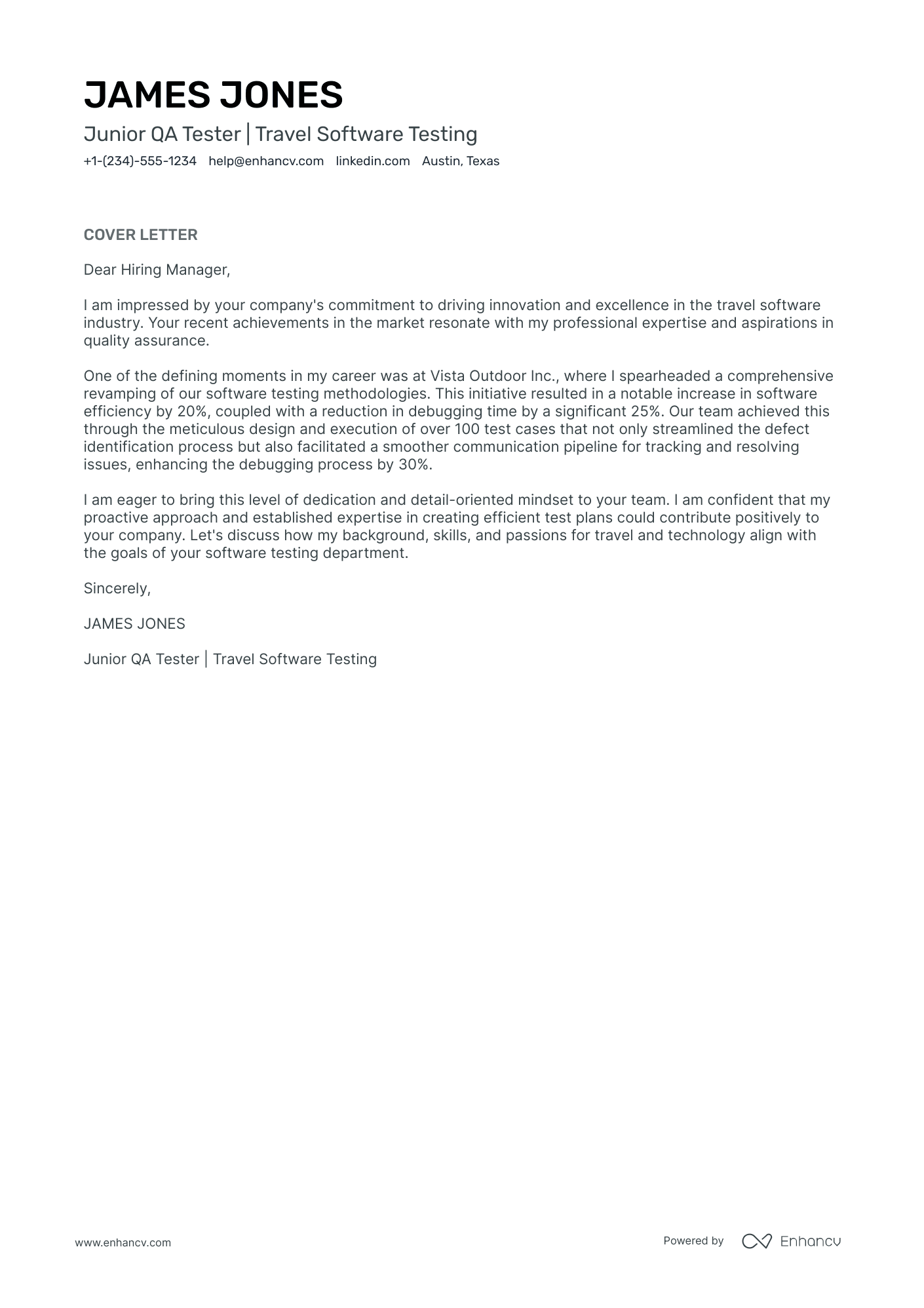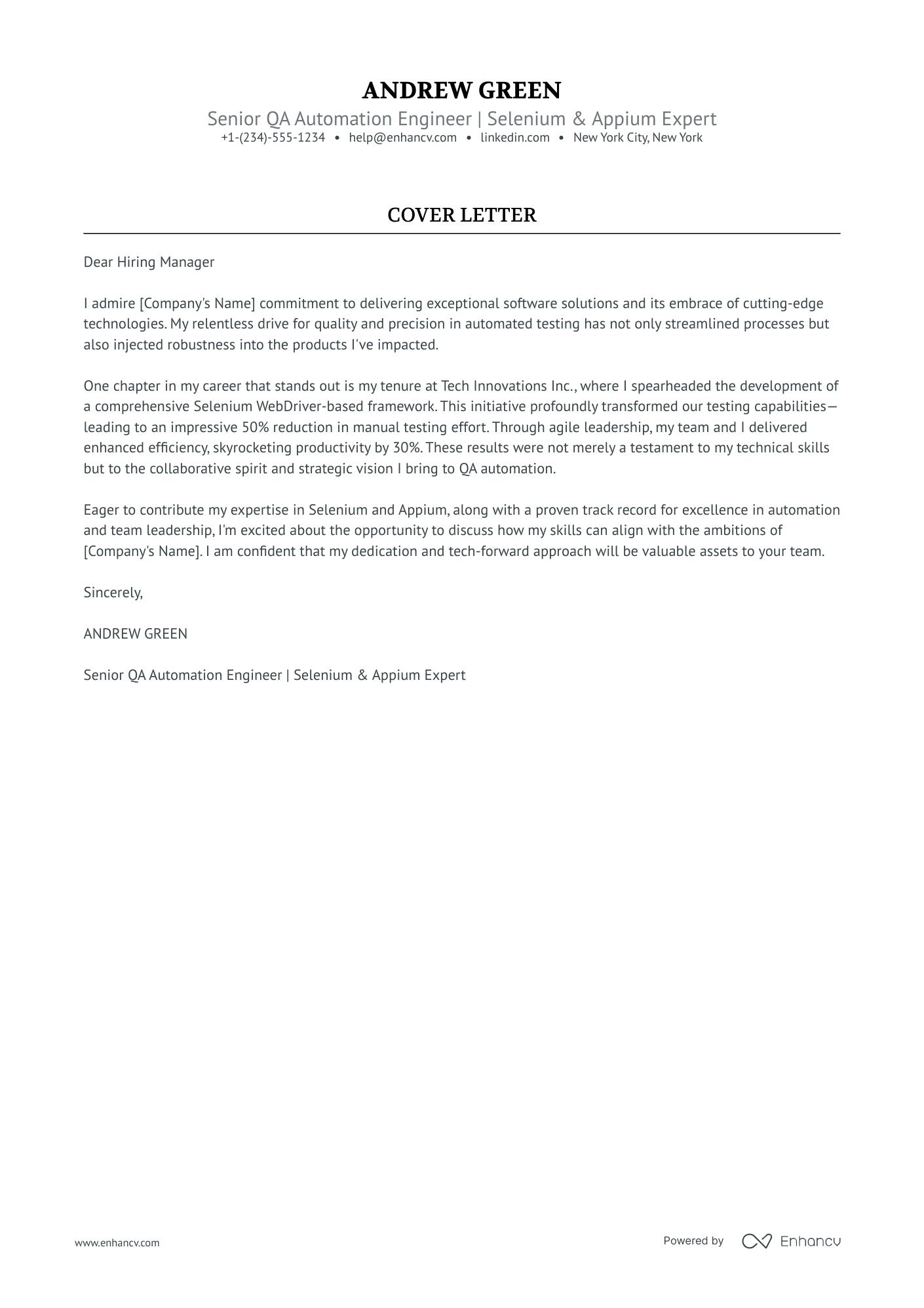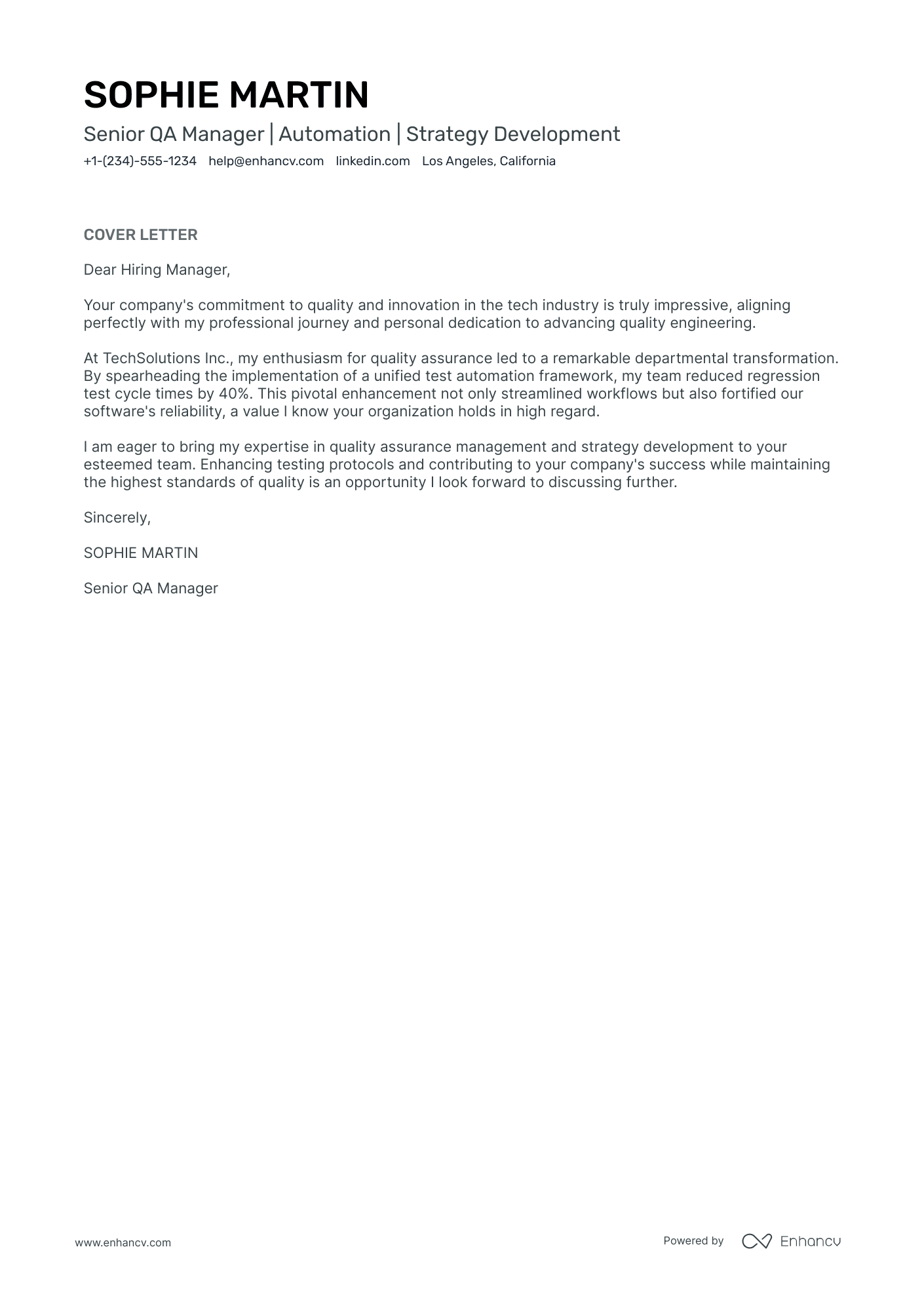Embarking on your job hunt, you've swiftly realized a compelling QA tester cover letter can set you apart. It's not an echo of your resume; it's the canvas for your crowning professional achievement, narrating the journey behind your success. Steer clear of the well-trodden path of clichés and strive for a touch of formality that still captures your unique voice. Keep it concise – a single page to showcase your story. Remember, in the world of first impressions, less is often more.
- Step your best foot forward in the qa tester cover letter introduction;
- Be inspired by other professionals' certified cover letters;
- Structure your qa tester cover letter to feature what matters most;
- Close off your qa tester cover letter to make a memorable impression on recruiters.
But where to start writing? Upload your resume into Enhancv's AI, which will prepare your qa tester cover letter (all you need to do is personalize it, and you'll be good to go).
If the qa tester isn't exactly the one you're looking for we have a plethora of cover letter examples for jobs like this one:
- QA Tester resume guide and example
- Facebook cover letter example
- Junior System Administrator cover letter example
- Technology Manager cover letter example
- .Net Developer cover letter example
- IT Audit Manager cover letter example
- Linux System Administrator cover letter example
- Salesforce Business Analyst cover letter example
- Network Security Engineer cover letter example
- Cloud Architect cover letter example
- Security Analyst cover letter example
Drop your resume here or choose a file.
PDF & DOCX only. Max 2MB file size.
QA tester cover letter example
Addison Harris
San Francisco, CA
+1-(234)-555-1234
help@enhancv.com
- Emphasizing relevant work experience, such as leading the development of automated testing suites, demonstrates a history of practical achievements and leadership.
- Quantifying success with specific metrics, like the 40% reduction in manual testing time, showcases the candidate’s impact and provides a concrete measure of their contributions.
- Expressing enthusiasm for teamwork and eagerness to collaborate with professionals at the company reflects a positive attitude and willingness to integrate with the existing company culture.
- Mentioning the adaptability to incorporate innovative solutions with existing methodologies shows flexibility and a forward-thinking approach to quality assurance.
The visual appeal of your qa tester cover letter: format, font, and structure
When using our cover letter builder, make sure to include these vital sections:
- Header (with your name, contact details, the role, and date);
- Greeting (that's personalized to the recruiter);
- Introductory paragraph (to capture attention);
- Body paragraph (to tell a story of how you've obtained your job-crucial skills);
- Closing paragraph (ending with a nod to the future ahead);
- Signature (that is not a must).
Our cover letter templates are already set up for you with the best qa tester cover letter design with single-spaced paragraphs and a one-inch margin.
As for the font of your qa tester cover letter, use the same one as you did in your resume (where modern and simple fonts, like Rubik and Bitter, take precedence over Arial and Times New Roman).
Your qa tester cover letter is created with the recruiters in mind - as no Applicant Tracker System looks over this part of your profile.
When sending over your qa tester cover letter, download it in PDF. This format allows your information and design to stay intact and to keep the same visual quality.
Writing cover letters just got easier. Use our free cover letter generator to create yours instantly.
The top sections on a qa tester cover letter
- Header: This section includes your contact information, ensuring the recruiter can easily reach you for an interview or any follow-up questions specific to the QA Tester position.
- Greeting: A personalized greeting to the hiring manager shows that you've researched who is responsible for hiring for the QA Tester role, portraying a genuine interest in the position and the company.
- Introduction: This opening paragraph grabs the recruiter's attention by succinctly expressing your enthusiasm for the QA Tester role and giving a brief overview of your relevant skills and experience.
- Body: In one or two paragraphs, this section highlights your specific qualifications, including technical abilities, experience in software testing, attention to detail, and any relevant certifications, demonstrating your fit for the QA Tester position.
- Closing & Call to Action: Conclude by reiterating your interest in the role, thanking the recruiter for considering your application, and indicating a willingness to discuss how your skills align with the goals of the QA Tester team in further detail.
Key qualities recruiters search for in a candidate’s cover letter
- Attention to Detail: Essential for identifying even the smallest issues that could impact software functionality or user experience.
- Technical Proficiency: Demonstrates the ability to use a range of testing tools and understand software development languages and methodologies.
- Analytical Skills: Key for breaking down complex software systems, formulating test cases, and understanding the implications of code changes.
- Communication Skills: Allows for effective collaboration with development teams and clear reporting of bugs and feedback.
- Adaptability: Reflects the capacity to quickly learn new technologies and adapt testing practices to different project requirements and evolving software environments.
- Problem-Solving Abilities: Indicates the competence to think critically and creatively to identify solutions to complex testing problems.
How to start your qa tester cover letter: with a greeting, of course
Have you ever considered just how powerful a personalized salutation can be?
We sure have news for you! Your qa tester cover letter should start with the right salutation to recruiters, nurturing a sense of respect and individuality.
Greet recruiters by using their first name (e.g. "Dear Tom" or "Dear Patricia") if you've previously established contact with them.
Otherwise, opt out for the less familiar, "Dear Ms. Peaches" or "Dear Ms Kelsey", if you've found the recruiter's name on LinkedIn or a corporate website.
"To whom it may concern" is never a good option, as it creates a sense that you've been sending out your qa tester cover letter to anyone. Instead, use "Dear HR team" or "Dear (company name) recruiter" for a feeling of exclusivity.
List of salutations you can use
- Dear Hiring Manager,
- Dear [Company Name] Team,
- Dear [Department Name] Manager,
- Dear Mr./Ms. [Last Name],
- Dear [Job Title] Hiring Committee,
- Dear [First Name Last Name] Selection Panel,
The qa tester cover letter intro: aligning your interest with the company culture
You only have one chance at making a memorable first impression on recruiters with your qa tester cover letter.
Structure your introduction to be precise and to include no more than two sentences.
Here are some ideas on how to write a job-winning qa tester cover letter introduction:
- get creative - show off your personality from the get-go (if this aligns with the company culture);
- focus on your motivation - be specific when you say what gets you excited about this opportunity.
What to write in the middle or body of your qa tester cover letter
Here's where it gets tricky.
Your qa tester cover letter body should present you in the best light possible and, at the same time, differ from your resume.
Don't be stuck in making up new things or copy-pasting from your resume. Instead, select just one achievement from your experience.
Use it to succinctly tell a story of the job-crucial skills and knowledge this taught you.
Your qa tester cover letter is the magic card you need to further show how any organization or team would benefit from working with you.
Closing remarks to end your qa tester cover letter
Of course, you'll have to show gratitude to the recruiters, who have assessed your profile at the end of your qa tester cover letter .
A "Thank you for the consideration" would work wonders, instead of the standard "Sincerely yours".
Do you want to make an even better impression?
Close off your qa tester cover letter by promising how you see yourself excelling in the role and the positive impact you'd bring about.
A sentence that encourages some further action on the recruiter's end could also be a good way to close off the communication (e.g. provide your availability for an interview).
Keep this in mind when writing your zero experience qa tester cover letter
Even though you may not have any professional experience, your qa tester cover letter should focus on your value.
As a candidate for the particular role, what sort of skills do you bring about? Perhaps you're an apt leader and communicator, or have the ability to analyze situations from different perspectives.
Select one key achievement from your life, outside work, and narrate a story that sells your abilities in the best light.
If you really can't think of any relevant success, you could also paint the picture of how you see your professional future developing in the next five years, as part of the company.
Key takeaways
Winning at your job application game starts with a clear and concise qa tester cover letter that:
- Has single-spaced paragraphs, is wrapped in a one-inch margin, and uses the same font as the qa tester resume;
- Is personalized to the recruiter (using their name in the greeting) and the role (focusing on your one key achievement that answers job requirements);
- Includes an introduction that helps you stand out and show what value you'd bring to the company;
- Substitutes your lack of experience with an outside-of-work success, that has taught you valuable skills;
- Ends with a call for follow-up or hints at how you'd improve the organization, team, or role.
QA Tester cover letter examples
By Experience
Junior QA Tester
By Role



















